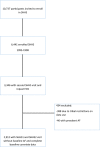Obstructive and Central Sleep Apnea and the Risk of Incident Atrial Fibrillation in a Community Cohort of Men and Women
- PMID: 28668820
- PMCID: PMC5586257
- DOI: 10.1161/JAHA.116.004500
Obstructive and Central Sleep Apnea and the Risk of Incident Atrial Fibrillation in a Community Cohort of Men and Women
Abstract
Background: Previous studies have documented a high prevalence of atrial fibrillation (AF) in individuals with obstructive sleep apnea (OSA). Central sleep apnea (CSA) has been associated with AF in patients with heart failure. However, data from prospective cohorts are sparse and few studies have distinguished the associations of obstructive sleep apnea from CSA with AF in population studies.
Methods and results: We assessed the association of obstructive sleep apnea and CSA with incident AF among 2912 individuals without a history of AF in the SHHS (Sleep Heart Health Study), a prospective, community-based study of existing ("parent") cohort studies designed to evaluate the cardiovascular consequences of sleep disordered breathing. Incident AF was documented by 12-lead ECG or assessed by the parent cohort. obstructive sleep apnea was defined by the obstructive apnea-hypopnea index (OAHI). CSA was defined by a central apnea index ≥5 or the presence of Cheyne Stokes Respiration. Logistic regression was used to assess the association between sleep disordered breathing and incident AF. Over a mean of 5.3 years of follow-up, 338 cases of incident AF were observed. CSA was a predictor of incident AF in all adjusted models and was associated with 2- to 3-fold increased odds of developing AF (central apnea index ≥5 odds ratio [OR], 3.00, 1.40-6.44; Cheyne-Stokes respiration OR, 1.83, 0.95-3.54; CSA or Cheyne-Stokes respiration OR, 2.00, 1.16-3.44). In contrast, OAHI was not associated with incident AF (OAHI per 5 unit increase OR, 0.97, 0.91-1.03; OAHI 5 to <15 OR, 0.84, 0.59-1.17; OAHI 15 to <30 OR, 0.93, 0.60-1.45; OAHI ≥30 OR, 0.76, 0.42-1.36).
Conclusions: In a prospective, community-based cohort, CSA was associated with incident AF, even after adjustment for cardiovascular risk factors.
Keywords: arrhythmia; atrial fibrillation; cohort; obstructive sleep apnea; sleep apnea.
© 2017 The Authors. Published on behalf of the American Heart Association, Inc., by Wiley.
Figures

References
-
- Lloyd‐Jones DM, Wang TJ, Leip EP, Larson MG, Levy D, Vasan RS, D'Agostino RB, Massaro JM, Beiser A, Wolf PA, Benjamin EJ. Lifetime risk for development of atrial fibrillation: the Framingham Heart Study. Circulation. 2004;110:1042–1046. - PubMed
-
- Mooe T, Gullsby S, Rabben T, Eriksson P. Sleep‐disordered breathing: a novel predictor of atrial fibrillation after coronary artery bypass surgery. Coron Artery Dis. 1996;7:475–478. - PubMed
MeSH terms
LinkOut - more resources
Full Text Sources
Other Literature Sources
Medical

